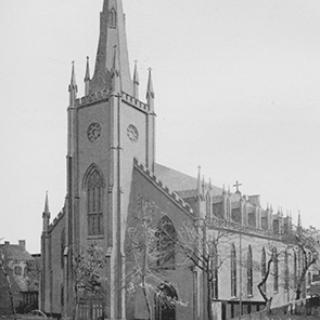1844 is the official founding date for the Parish of Ss. Peter and Paul, although the history of the parish goes back to 1837. That is the date of the first recorded mass in Williamsburgh, which took place in a private home on Fourth Street (Bedford Avenue) between South 3rd and South 4th Street1. The services were conducted by a priest from St. Mary’s Church, Grand Street, New York (sources alternately identify him as Father Dougherty or Father Bradley). The priest from St. Mary’s would come to Williamsburgh once a month to hold services. Soon thereafter, the priest rented “an old building that had been used as a stable” on Grand Street. Malone describes this as being west of Fourth Street (Bedford), while the Times describes it as west of Third (Berry). The first mass in this building was in the summer of 1838, but the church closed after a few months due to lack of support.
In the Spring of 1840, Reverend James O’Donnell, an Augustinian priest who was the cousin of the Nicholas O’Donnell, pastor of St. Paul’s Church on Court Street, visited Williamsburgh with the intention of building a church. O’Donnell purchased six lots on the outskirts of the village at the northeast corner of North 8th Street and First Street (Kent) from Col. Francis Titus. O’Donnell hired a local builder, John Brown, to erect a frame church with a capacity of 500 people. The remaining ground was used as a cemetery.
This new church was called St. Mary’s and was dedicated on June 27, 1840 by the Right Reverend John Dubois, the second Bishop of the Diocese of New York. The first marriage recorded in the parish register was that of Michael Kenny and Catherine Egan, in July 1839.
During his tenure, O’Donnell visited the parish weekly. He was succeeded in April of 1844 by Reverend William P. Hogan, a nephew of Rev. Nicholas O’Donnell. In September 1844, Bishop Hughes of the Diocese of New York appointed Reverend Sylvester Malone as the first resident pastor of the parish. The parish at this time extended from Hallet’s Cove in Queens to Myrtle Avenue in East Brooklyn, and as far east as Middle Village, Queens.
In 1845 or 1846, Rev. Malone purchased a plot of land on Second Street (Wythe) between South 2nd and South 3rd to construct a new church closer to the center of the village. Strong anti-Catholic sentiment led Malone to sit on the property for a year and a half. Finally, Malone floated the idea of moving the Church’s cemetery to the Southside but leaving the church itself on the Northside. According to Malone, “This brought the townspeople to terms. They preferred a church, even though it be Catholic, to a graveyard”.
Malone hired Patrick Keely to design the new church, which by this time had been renamed Sts. Peter and Paul in order to avoid confusion with St. Mary’s Parish in Manhattan. The cornerstone for the new church was laid by Bishop Hughes on Sunday, May 30, 1847 (the Times gives the date as March 11). The new church was dedicated on May 7, 1848 and is described (by Malone) as the first church in the Diocese of New York to be designed in the Gothic style.
The first division of the Parish came in about 1854, when St. Mary BVM parish was established on Leonard Street. St. Anthony of Padua, Greenpoint, was a later subdivision of Sts. Peter and Paul Parish.
On November 11, 1860, the old frame church at North 8th Street was rededicated as St. Vinvent de Paul.
- 1Most of the information contained here is taken from Sylvester L. Malone, ed., Memorial of the Golden Jubilee of the Reverend Sylvester Malone(Brooklyn, N.Y.: J.J. Little & Co., printer, 1895); additional details can be found in “The Ecclesiastical History of Williamsburgh,” Brooklyn Times, February 26, 1898: 6.
- Log in to post comments
